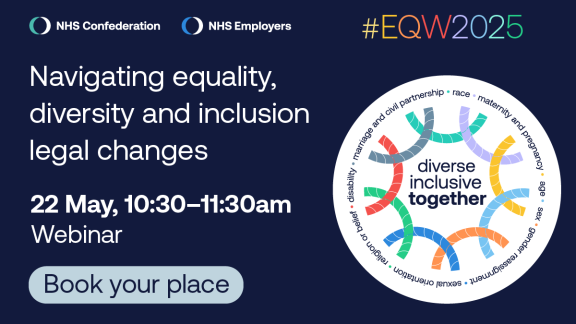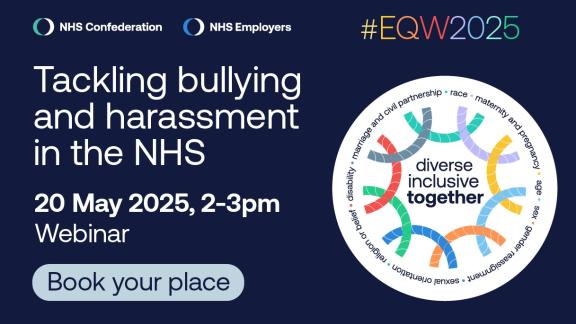NHS Employers commissioned the Clear Company to identify and explore the relationship between disability declaration rates, staff engagement rates and experiences of people with disabilities. These findings have now been used to update this guide to improving staff disability data.

Introduction
Following the introduction of the NHS Workforce Disability Equality Standard (WDES) and the mandated requirements that trusts are now subjected to - it is perhaps more important than ever that the NHS is inclusive and welcomes disabled people. A positive and proactive approach by employers towards disability, both during the recruitment process and as part of everyday management, is key to creating an inclusive and open culture.
The NHS Workforce Plan and NHS Equality, Diversity and Inclusion improvement plan published by NHS England set out an ambition for the health and social care sector to recruit and retain from a wider cross-section of the community. WDES has been developed to help NHS organisations monitor and measure whether they are effectively doing this in respect of disabled people.
The WDES requires NHS organisations to implement evidence-based actions in response to issues identified through their WDES metrics data, so it is important that employers look to improve disability declaration rates and build a more accurate picture of the diversity of their workforce.
Nationally, there is an under-reporting of disability information:
- Around 15 per cent of NHS staff actively choose not to share whether they have a disability or not and for another 15 per cent of staff there is no information held on their employment record.
- Only 4.2 per cent of NHS staff have declared a disability through the NHS Electronic Staff Record (ESR) system. This compares to about 20 per cent of NHS Staff Survey respondents identifying themselves as disabled.
The Office for National Statistics data indicates that a similar percentage (around 20 per cent) of people in employment across the UK are disabled. In addition, many people do not consider themselves to have a disability or long-term condition as defined by the Equality Act 2010. For example, staff may be unaware that cancer and mental health conditions are recognised as disabilities, and so affected staff may not report it as such.
Employers should seek to improve their data and reduce the amount of missing information by encouraging staff to speak about their lived experiences to their managers and identify and record their disability on ESR.
This briefing provides guidance and tips for employers on how they can improve their disability data locally by using the recruitment process, manager engagement and data collection more effectively.
Take steps to be more inclusive with your recruitment
The recruitment process is a crucial first point of contact between an employer and potential employees. It provides an opportunity for employers to demonstrate they are inclusive, to build trust and to give disabled people the confidence and opportunity to say that they have a disability. This information can then be captured early on in the process and recorded on ESR.
Tips
- Use positive visual workplace images of disabled people in any recruitment and induction materials.
- Use quotes and short case studies directly from currently employed disabled staff, talking about their experience of working in your organisation.
- Include clear written statements in recruitment materials about how accessible materials can be obtained in different formats such as braille or large print.
- Use clear statements at recruitment events, as an introduction to an interview, or during inductions, about the organisation’s commitment to create inclusive workplace cultures that welcome disabled people.
- Share information in your recruitment materials about how the organisation supports disabled people and what they can expect when they join. For example, access to a disabled staff network/peer support group and opportunities to sign up to targeted career development opportunities.
- Provide clear information about the organisation’s commitment and approach to reasonable adjustments.
- Make sure interview candidates have an opportunity to share information about any disability that they may have and whether they require any support, such as reasonable adjustments for tests, interviews and any other part of the recruitment process.
- Make a commitment to recruit more people with learning disabilities.
- Consider introducing internships and work experience placements for people with disabilities and learning disabilities, using schemes such as Project Search and Choices College.
- Join the national Disability Confident scheme, which encourages employers to think differently about disability and how they recruit, retain and develop disabled people.
Encourage existing staff to share their disability
Staff will only feel comfortable and confident to talk about their disability if they believe their employer will respond positively and proactively. The Clear Company findings demonstrated that organisations that had embedded the social model of disability performed highly on declaration rates. This model states that people are disabled by barriers in society, not by their impairment or difference. Organisations should consider incorporating actions to tackle these barriers into a wider programme of work that can help create a compassionate, inclusive and welcoming workplace where disabled staff - and indeed anyone who might consider themselves to be in a minority group or disadvantaged in any way - feel safe and secure to share their disability status, or other equality information.
There is an intersection between age and disability, as the older you get the more likely you are to acquire a disability. According to The Centre for Policy on Ageing: ‘By far the largest proportion - 36 per cent - of over 50s who stay in employment after acquiring a disability are in public administration, education and health.’
A 2018 report by the Royal College of Nursing stated: ‘In 2013, around one in six nurses were aged 56 or over, compared to almost one in five (19 per cent) in 2018’. It’s therefore important for employers to recognise that existing staff may acquire or may have already acquired a disability during their employment but may not have reported this. Employers should foster an open culture for staff to share this information and emphasise the benefits this brings.
Tips
- Develop and publicise a robust equality, diversity and inclusion strategy that includes reference to disability as a key strand for success. Provide regular updates on progress on this strategy.
- Create a psychologically safe workplace, free from stigma, where there are open and honest conversations around the opportunities that declaring a disability creates.
- Share case studies, stories and have awareness raising sessions that highlight the benefit that disabled staff bring to the organisations. These should highlight how declaration rates can help trusts now and for future generations of employees and patients.
Be clear about why you are collecting the data
Sharing data on disability or long-term conditions can be difficult for many reasons. There are benefits for both staff and the employer in building better quality data on disability. For staff, the benefits in sharing data include:
- prompting a discussion with their employer about reasonable adjustments or other workplace support that they might require
- receiving targeted information about support or positive action initiatives, such as career development programmes or disabled staff networks
- contributing to a pool of information that will help the employer monitor its workforce and meet the diverse needs of staff, for example in relation to provision of accessible estates and facilities.
Tips
- Be clear in your communications as to why the data is being collected, how the data will be used, who will have access to this information and the benefits it will bring. For example, a staff member may share their disability and reasonably assume that this will prompt a discussion about disability support, when in fact the data is only being used for anonymous monitoring purposes.
- Use inclusive terminology when communicating the importance of declaring and sharing a disability status. Many of those with long-term conditions, those who are neurodivergent or who have mental health conditions may not consider themselves to have a disability and so communications should make the definition of disability for the purposes of accumulating this data.
- When starting a conversation with a member of staff about reasonable adjustments, give them the opportunity to talk openly about their disability and encourage them to record this on ESR.
- Provide clear guidance and support on how to update ESR on intranet pages, from managers and during the onboarding process.
- Proactively use the disability monitoring data to build a better understanding of any barriers in the recruitment and selection process that may disadvantage disabled applicants.
- Equally, use the data to understand the workforce profile and identify interventions that may support disabled staff to progress their careers. Remember, 83 per cent of disabled people acquire their disability when they are of working age. (ONS data)
Dedicating time to audit and cleanse data
Scheduling time to undertake data verification exercises is crucial. It provides an opportunity to interact with staff, reminding them why data is being collected, how it will be used and stored, and the importance of recording their disability on ESR. The data received will allow you to better understand the needs of your workforce and take positive steps to improve the working environment and workplace culture for your staff.
Tips
- Audit your current data sets and undertake a data cleansing exercise.
- Promote information through internal communications channels, such as intranet sites or staff newsletters, inviting existing staff to check that all their personal data held on ESR is accurate, and then update accordingly. This could be done annually, with quarterly reminders. It could also form part of a mid-year and annual appraisal meetings.
- Use the updated information to provide personalised support, for example by introducing reasonable workplace adjustments.
- Consider introducing the self-service element of ESR so that staff can update their own records more easily. Having this control may encourage more staff to report their information. If you have this in place, make sure information on how to complete this is clearly signposted.
- Set a declaration rate target with monthly updates to help set standards and tackle issues in the moment, rather than waiting for an annual update. One of the highest performing trusts for disability declaration rates set an objective of 15 per cent and monitored their progress against this with updates on progress for disability declaration being part of monthly reporting.
- Use this data to drive key short and long term actions and make sure these are coordinated and consistent across the organisation.
- Compare your disability declaration rates data to that published in the WDES annual national report. This report includes comparisons of data by trust types and regions. Reviewing data will help employers to identify whether there is more they need to do to support staff to share their disability.
Encouraging line managers to start a conversation
Some staff may not feel confident and not want to talk about their disability. They may feel that it would have a detrimental impact on their jobs and careers. Demonstrating inclusive, kind, compassionate leadership can lead to staff feeling more supported and empowered to discuss and share their disability.
Manager behaviours can have a huge impact on disabled staff experience. By starting a conversation, a manager can gain a better understanding of concerns their staff might have about sharing details of their disability on ESR. It’s also an opportunity to talk about any support the individual needs with a view to making reasonable adjustments in the workplace.
Tips
- Think about the terminology - try to avoid terms like ‘disclosure’ which can be seen as negative and feel daunting, embarrassing, formal and legalistic. Instead, adopt for more friendly language that will help foster trust and inclusion, and will encourage people to feel able to open up about their disability. For example, ask people to ‘share’ or ‘tell’.
- Educate line managers on the social model of disability, have easily accessible intranet pages and clearly signpost frontline staff to the health passport. The relationship between line managers and their staff should create a culture of open communication.
- Provide support for managers for funding and applications for new reports on disability to allow them to monitor progress.
- Get a senior leader to support the campaign and host online chats or webinars where they lead on the benefits to staff of sharing their disability. Trusts that have an open culture of speaking about personal experiences, with clear role models in senior leadership, have better declaration rates. A good example of this is a podcast by Deborah Lee, a chief executive of an NHS trust who has opened up about her disability and the positive impact this had.
- Widen the campaign - include social media messaging that will help reach the public and local communities. Consider linking this to a recruitment campaign to encourage more applications from disabled people in your local area.
Running a communications campaign
Consider launching a positive and proactive communications campaign to engage with staff, with the aim of encouraging conversations around disability and the importance of recording this information on ESR.
The campaign could take the form of posters that promote role models, articles in staff newsletters or blogs written by the organisation’s disabled staff network members.
Tips
- Incorporate into line manager training the importance of ensuring disability equality and the social model of disability in the workplace, their responsibilities as a manager and how they can play an active role in supporting disabled staff.
- Have conversations about disability within an overall message of creating inclusive and compassionate workplaces for all staff. One of the highest performing trusts created a video with staff documenting the importance of declaring, having conversations and examples of beneficial changes. This was launched across the organisation and included instructions for how to update data. It also included guidance on having conversations with managers, appraisals and how to weave in data to those conversations.
- Encourage managers to be proactive and start a conversation with both new and existing staff during regular supervision, one-to-one meetings, appraisals and return-to-work interviews.
- Take an inclusive approach to conversations. For example, consider using principles from Making Every Contact Count (MECC). Whilst MECC is patient focused, it can also be applied to conversations with staff about disability.
- Consider whether a member of staff is stressed or experiencing a mental health condition. The mental health charity Mind and the Chartered Institute of Personnel Development (CIPD) have developed a good practice guide for managers to help them manage mental health issues at work.
- NHS Employers have developed an interactive emotional wellbeing toolkit How are you feeling today? to help start conversations.
- Read a report by disability charity Scope Let’s talk: improving conversations about disability at work, which includes tips for employers to encourage staff to share information about their disability or health condition.
Engaging with staff networks and communications colleagues
Employers should proactively seek to work with staff networks and trade unions in any campaign or initiative to improve declaration rates. The Clear Company report showed that trusts which elevated staff networks and empowered their staff networks to help make changes performed highly on declaration rates.
This approach is supported by the ethos of ‘nothing about us without us’ and means involving disabled people in any decisions that you make that will have an impact on disabled people.
Working with these key stakeholders will allow you to connect, understand concerns, gain buy-in and improve staff engagement.
Tips
- Take steps to engage with both disabled staff and trade unions at every opportunity.
- Consider a joint campaign with staff to encourage them to share their disability to support both their employment and union records.
- If your organisation hasn’t already established a disabled staff network, it is worth considering if there is an appetite for one. Invite staff to share their views on whether a network should be introduced.
- Proactively consider and discuss the likelihood of undeclared disability when dealing with employment relations cases.



